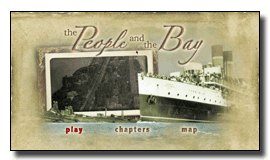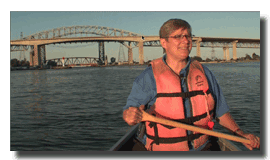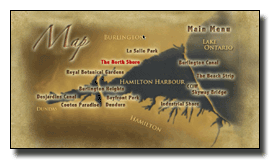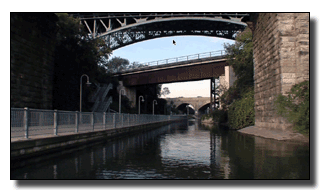The Wilson Centre in Canadian History officially launched an awesome new learning tool  destined for the classrooms of local schools last night. The People and the the Bay is an historical environmental documentary created by Nancy Bouchier, Ken Cruikshank and the wizards from Pixel Dust Studios This stunning production brings a vivacity, zest, and probing depth to explore the unique relationship between the Hamilton harbour and the lives of people in the area and the city itself. The occasion was celebrated at the Canada Marine Discovery Centre, a uniquely appropriate site for presenting this production. The centre sits on the harbour and is an interpretative museum dedicated to Canada’s rich aquatic heritage.
destined for the classrooms of local schools last night. The People and the the Bay is an historical environmental documentary created by Nancy Bouchier, Ken Cruikshank and the wizards from Pixel Dust Studios This stunning production brings a vivacity, zest, and probing depth to explore the unique relationship between the Hamilton harbour and the lives of people in the area and the city itself. The occasion was celebrated at the Canada Marine Discovery Centre, a uniquely appropriate site for presenting this production. The centre sits on the harbour and is an interpretative museum dedicated to Canada’s rich aquatic heritage.
 Nancy Bouchier, one of the co-authors/presenters of the programme suggests that when most of us think of Hamilton we picture, ” a successful but grimy, industrial city.” The backdrop to this is steel mills, steamers, traffic and smokestacks. But, as Ken Cruikshank, our other guide asserts, it’s much more than this and Hamilton is a city rediscovering its rich heritage by reconnecting to the harbour. Over the next 45 minutes Ken and Nancy bring to life the richness of past connection to Burlington Bay and leave us with a hopeful appreciation for the continued revitalization of the body of water that has been so central to the growth of the area. The natural beauty of the harbour area is highlighted – an aspect of the Hamilton harbour area that is far too easy to miss. You have to walk the trails, sail in the harbour and maybe produce a documentary production, to truly find this beauty. When you immerse yourself in the area you can find it, but it does take effort.
Nancy Bouchier, one of the co-authors/presenters of the programme suggests that when most of us think of Hamilton we picture, ” a successful but grimy, industrial city.” The backdrop to this is steel mills, steamers, traffic and smokestacks. But, as Ken Cruikshank, our other guide asserts, it’s much more than this and Hamilton is a city rediscovering its rich heritage by reconnecting to the harbour. Over the next 45 minutes Ken and Nancy bring to life the richness of past connection to Burlington Bay and leave us with a hopeful appreciation for the continued revitalization of the body of water that has been so central to the growth of the area. The natural beauty of the harbour area is highlighted – an aspect of the Hamilton harbour area that is far too easy to miss. You have to walk the trails, sail in the harbour and maybe produce a documentary production, to truly find this beauty. When you immerse yourself in the area you can find it, but it does take effort.  It may be easier to do this today, as the DVD conveys, but it is still all too often hidden behind a veil of smog, or camouflaged by industry that scares one away from wanting to get too close. Our commentators do get close to the nature of the harbour. They walk the trails, wander the parks and cemeteries, and in Bouchier’s case canoe the bay to bring a new appreciation to viewers.
It may be easier to do this today, as the DVD conveys, but it is still all too often hidden behind a veil of smog, or camouflaged by industry that scares one away from wanting to get too close. Our commentators do get close to the nature of the harbour. They walk the trails, wander the parks and cemeteries, and in Bouchier’s case canoe the bay to bring a new appreciation to viewers.
Pixel Dust Studios and director Zach Melnick have woven their magic to deliver this amazing historical-environmental documentary. I wax gushingly, but honestly admit that this programme is crafted with a special touch. The cinematography is superbly shot, composed and rendered with original music. They combine historical re-enactments, with stock and historical footage to create an engaging and pertinent production that is testament to their ability not only as filmmakers,  but as craftspeople who work with historical material with tremendous sensitivity. The DVD is presented in both SD and HD formats as well, giving the viewer an added visual treat.
but as craftspeople who work with historical material with tremendous sensitivity. The DVD is presented in both SD and HD formats as well, giving the viewer an added visual treat.
It will be valuable to follow the classroom adoption and use of this DVD. As these are distributed to local history teachers for use in their classrooms, the true benefits and impact of the product will be recognized. It has been authored with this use in mind. The duration of the programme is geared towards being able to show within a single class period. It is nicely segmented into short chapters and these can be used to support specific events and study foci. Additionally, and I appreciate this one, one of the navigation options is spatial. The particular chapters have been mapped to their locations around the harbour. All we are missing is a separate chronological timeline view.  The wealth of options hopefully will allow varied uses for the product and for convenient enhancement of existing curricula. Will the addition lead to the discussion that the producers clearly hope to engender? I hope and believe it will, and look forward to discovering how it does work. One thing is of little doubt, this product raises the bar for tools to aid in teaching Canadian history in the classroom. I fervently hope that this is only the first of such productions that can bring a compelling and media-competitive edge to teachers who have to battle the pervasiveness of block buster historical epics that lead students to conclude that Canadian history is boring.
The wealth of options hopefully will allow varied uses for the product and for convenient enhancement of existing curricula. Will the addition lead to the discussion that the producers clearly hope to engender? I hope and believe it will, and look forward to discovering how it does work. One thing is of little doubt, this product raises the bar for tools to aid in teaching Canadian history in the classroom. I fervently hope that this is only the first of such productions that can bring a compelling and media-competitive edge to teachers who have to battle the pervasiveness of block buster historical epics that lead students to conclude that Canadian history is boring.
Last year I had the privilege to assist Dr. Viv Nelles, the LR Wilson Chair, and person responsible for initiating this project, when he presented the Introduction to Canadian History course. He re-imagined the presentation of what is a staple course for history departments in Canada and created a fresh and dynamic offering for his students. His innovative approach combined pertinent themes with an appreciation for the broader context of the interaction between man and nature. Judging from my interaction with the students, engaged them in a course many expect to be a yawn fest.  This went so far as one student confiding to me that she had actually suffered from nightmares following his eerie telling of tales of the loup-garou and its role in Québecois society. You know you are reaching students when… This new teaching tool for high school history teachers smacks of this dedication to innovation and revitalization of the teaching of our history.
This went so far as one student confiding to me that she had actually suffered from nightmares following his eerie telling of tales of the loup-garou and its role in Québecois society. You know you are reaching students when… This new teaching tool for high school history teachers smacks of this dedication to innovation and revitalization of the teaching of our history.
I was planning to blog after attending the DVD launch last night. I ruminated over words and messages and continued to do so as I drove to the office this morning. And that’s when it hit me. As I drove along the 403 I passed many of the points highlighted in the production. We can all too easily miss the context of our everyday life. Tasks and places are rooted in our shared existence with others and with the past. The historical context deepens out understanding, our appreciation and hopefully our sensitivity to place. We can be sensitive to their care, sympathy, stewardship and struggles with problems that we face today and continue in their efforts. Through productions like ‘The People and the Bay,’ we are made aware that these processes that are longer than our lifetimes and often memories, but that awareness leads to new appreciation not just of superficial beauty, but can inspire the the strength and dedication to build on the efforts of our ancestors.
Note: The most beautiful sequence for me is the 6 spans crossing the Dejardins canal captured in the image above, and presented at the beginning of chapter 9. The slow progression through the ancient waterway and the perfect lighting conditions really resonated with me.

Update: The Hamilton Spectator has great coverage of the launch.
